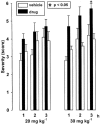Effects of adenosine receptor agonists and antagonists in a genetic animal model of primary paroxysmal dystonia
- PMID: 11564652
- PMCID: PMC1572962
- DOI: 10.1038/sj.bjp.0704268
Effects of adenosine receptor agonists and antagonists in a genetic animal model of primary paroxysmal dystonia
Abstract
1. Recent studies have shown beneficial effects of an adenosine A(2A) receptor agonist in dt(sz) mutant hamsters, an animal model of paroxysmal dystonia, in which stress and consumption of coffee can precipitate dystonic attacks. This prompted us to examine the effects of adenosine receptor agonists and antagonists on severity of dystonia in dt(sz) hamsters in more detail. 2. The non-selective adenosine A(1)/A(2A) receptor antagonists, caffeine (10 - 20 mg kg(-1) i.p.) and theophylline (10 - 30 mg kg(-1) s.c.), worsened the dystonia in dt(sz) hamsters. 3. Aggravation of dystonia was also caused by the selective adenosine A(1)/A(2A) antagonist CGS 15943 (9-chloro2-2-furyl)[1,2,4]triazolo[1,5-c]quinazolin-5-amine) at a dose of 30 mg kg(-1) i.p. and by the adenosine A(1) antagonist DPCPX (8-cyclopentyl-1,3-dipropylxanthine; 20 - 30 mg kg(-1) i.p.), while the A(2) antagonist DMPX (3,7-dimethyl-1-propargylxanthine; 2 - 4 mg kg(-1) i.p.) and the highly selective A(2A) antagonist ZM 241385 (4-(2-[7-amino-2-(2-furyl)[1,2,4]triazolo[2,3-a][1,3,5]triazin-5-ylamino]ethyl)phenol; 2 - 5 mg kg(-1) i.p.) failed to exert any effects on dystonia. 4. In contrast to the antagonists, both the adenosine A(1) receptor agonist CPA (N(6)-cyclopentyladenosine; 0.1 - 1.0 mg kg(-1) i.p.) and the A(2A) agonist CGS 21680 (2p-(2carboxyethylphen-ethylamino-5'-N-ethylcarboxamindoadenosine; 0.1 - 2.0 mg kg(-1) i.p.) exerted a striking improvement of dystonia. 5. These data suggest that the precipitating effects of methylxanthines are, at least in part, related to their adenosine receptor antagonistic action. 6. Although adenosine receptor agonists can be regarded as interesting candidates for the therapy of paroxysmal dystonia, adverse effects may limit the therapeutic potential of adenosine A(1) agonists, while beneficial effects of the adenosine A(2A) agonist CGS 21680 were already found at well tolerated doses.
Figures







Similar articles
-
Decreased adenosine receptor binding in dystonic brains of the dt(sz) mutant.Neuroscience. 2005;134(1):33-8. doi: 10.1016/j.neuroscience.2005.03.033. Neuroscience. 2005. PMID: 15961243
-
Activation of multiple sites by adenosine analogues in the rat isolated aorta.Br J Pharmacol. 1996 Jul;118(6):1509-17. doi: 10.1111/j.1476-5381.1996.tb15567.x. Br J Pharmacol. 1996. PMID: 8832079 Free PMC article.
-
Cross talk between A(1) and A(2A) adenosine receptors in the hippocampus and cortex of young adult and old rats.J Neurophysiol. 1999 Dec;82(6):3196-203. doi: 10.1152/jn.1999.82.6.3196. J Neurophysiol. 1999. PMID: 10601453
-
The role of the adenosinergic system in lung fibrosis.Pharmacol Res. 2013 Oct;76:182-9. doi: 10.1016/j.phrs.2013.08.004. Epub 2013 Aug 28. Pharmacol Res. 2013. PMID: 23994158 Review.
-
Xanthines as adenosine receptor antagonists.Handb Exp Pharmacol. 2011;(200):151-99. doi: 10.1007/978-3-642-13443-2_6. Handb Exp Pharmacol. 2011. PMID: 20859796 Free PMC article. Review.
Cited by
-
Neuroprotection by adenosine in the brain: From A(1) receptor activation to A (2A) receptor blockade.Purinergic Signal. 2005 Jun;1(2):111-34. doi: 10.1007/s11302-005-0649-1. Epub 2005 Mar 17. Purinergic Signal. 2005. PMID: 18404497 Free PMC article.
-
Multitarget Multiscale Simulation for Pharmacological Treatment of Dystonia in Motor Cortex.Front Pharmacol. 2016 Jun 14;7:157. doi: 10.3389/fphar.2016.00157. eCollection 2016. Front Pharmacol. 2016. PMID: 27378922 Free PMC article.
-
Multiple adenosine receptor subtypes stimulate wound healing in human EA.hy926 endothelial cells.Purinergic Signal. 2019 Sep;15(3):357-366. doi: 10.1007/s11302-019-09668-z. Epub 2019 Jun 28. Purinergic Signal. 2019. PMID: 31254200 Free PMC article.
-
The neurobiological basis for novel experimental therapeutics in dystonia.Neurobiol Dis. 2019 Oct;130:104526. doi: 10.1016/j.nbd.2019.104526. Epub 2019 Jul 4. Neurobiol Dis. 2019. PMID: 31279827 Free PMC article. Review.
-
Electrophysiological insights into deep brain stimulation of the network disorder dystonia.Pflugers Arch. 2023 Oct;475(10):1133-1147. doi: 10.1007/s00424-023-02845-5. Epub 2023 Aug 2. Pflugers Arch. 2023. PMID: 37530804 Free PMC article. Review.
References
-
- ABERCROMBIE E.D., KEEFE K.A., DIFRISCHIA D.F., ZIGMOND M.J. Differential effects of stress on in vivo dopamine release in striatum, nucleus accumbens and medial frontal cortex. J. Neurochem. 1989;52:1655–1658. - PubMed
-
- BHATIA K.P., MARSDEN C.D. The behavioural and motor consequences of focal lesions of the basal ganglia in man. Brain. 1994;117:859–876. - PubMed
-
- DEMIRKIRAN M., JANKOVIC J. Paroxysmal diskinesias: clinical features and classification. Ann. Neurol. 1995;38:571–579. - PubMed
-
- FAHN S.The paroxysmal dyskinesias Movement Disorders 3 1994Oxford: Butterworth-Heinemann; 311–345.eds. Marsden, C.D. & Fahn, S. pp
-
- FAHN S., BRESSMAN S.B., MARSDEN C.D.Classification of dystonia Advances in Neurology, vol. 78, Dystonia 3 1998New York: Lippincott-Raven; 1–10.eds. Fahn, S., Marsden, C.D. & DeLong, M.R - PubMed
Publication types
MeSH terms
Substances
LinkOut - more resources
Full Text Sources
Other Literature Sources
Medical

